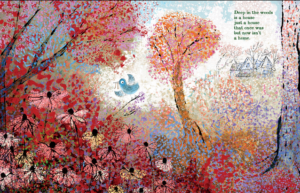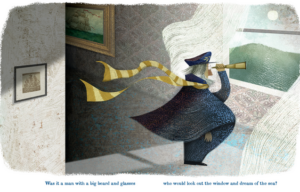Review of the Day: A House That Once Was by Julie Fogliano, ill. Lane Smith
 A House That Once Was
A House That Once Was
By Julie Fogliano
Illustrated by Lane Smith
Roaring Brook Press (an imprint of Macmillan)
$18.99
ISBN: 978-1-62672-314-6
Ages 4-7
On shelves May 1st
When I was growing up there was an empty house across the street. A melancholy, haunted structure that seemed to wear its sadness like a badge. No one ever moved into it that I can recall, and the neighborhood kids would attempt to conjure up ghost stories to match its tired visage. I never went in it. Never even peeked in the window, though I longed to. To a kid, an abandoned house is better than a snow fort, a play structure, or a climbing tree combined. An empty house has history and mystery all wrapped up in its very foundations. And now, since the housing crash of 2008, abandoned houses are not the rare structures they once were. Many have been abandoned mid-occupation, their former occupants leaving behind clues about their very lives. You might look on that fact and think about how sad it is. It takes a true children’s writer to see the potential there. To cast their mind back and remember what it was like to be a kid and to explore the unknown, if only for a little while. Now Julie Fogliano and Lane Smith (a duo that feels as old as time but have only just now been paired together on a project) have brought a little life back to a dilapidated home. Better than pirates. Better than princesses. The ultimate fantasy: A house that once was.
A walk in the woods takes two children to a house that can no longer be called a home. Windows are boarded up, it slants slightly to one side, and an oddly cheery whale-themed weathervane perches on the roof. Apprehensive at first, the two kids approach with caution, and then enter. There they find the remnants of a life. Books and old toys and a bed “still made”. Old photos. Broken frames. Together they imagine the people that might have lived behind these walls. People with dreams and talents and hopes. Are they okay? Are they happy? They are gone but the house is still here, but whether it’s waiting or content with its lot we can never know. So the kids go back to their own house, not yet mysterious, leaving behind “a house that once was but now isn’t a home.”
 Ms. Fogliano is a difficult woman to pin down. In many ways, she is one of our most accomplished picture book writers working today. I say that, but you won’t find her name plastered all over Times Square or bandied about the pages of The New York Times. Because her specialty is concentrated, contemplative quiet, by the very nature of her style she is doomed to dwell under the radar. I suspect that this may suit her. And I also suspect that if she keeps cranking out books as good as this one then that quiet beauty she’s so cornered the market on may become downright fashionable. In A House That Once Was I felt the tug of so many other picture books lurking just beneath the text. Consider the last sentences in the book. “Back to a house where our dinner is waiting. Back to a home that is cozy and warm. Deep in the woods is a house just a house that once was but now isn’t a home.” I don’t know about you but I felt hints of This Is the House That Jack Built, Bringing the Rain to Kapiti Plain, and the ending of Where the Wild Things Are in those sentences.
Ms. Fogliano is a difficult woman to pin down. In many ways, she is one of our most accomplished picture book writers working today. I say that, but you won’t find her name plastered all over Times Square or bandied about the pages of The New York Times. Because her specialty is concentrated, contemplative quiet, by the very nature of her style she is doomed to dwell under the radar. I suspect that this may suit her. And I also suspect that if she keeps cranking out books as good as this one then that quiet beauty she’s so cornered the market on may become downright fashionable. In A House That Once Was I felt the tug of so many other picture books lurking just beneath the text. Consider the last sentences in the book. “Back to a house where our dinner is waiting. Back to a home that is cozy and warm. Deep in the woods is a house just a house that once was but now isn’t a home.” I don’t know about you but I felt hints of This Is the House That Jack Built, Bringing the Rain to Kapiti Plain, and the ending of Where the Wild Things Are in those sentences.
Look too at how Fogliano’s books beg to be read aloud. Her magnum opus (until now) was the poetry book When Green Becomes Tomatoes, a book too easily forgotten for all the beauty it was capable of conjuring. That book was a readaloud dream. In this title Fogliano put her lines in the form of a poem with natural breaks, soft rhymes, and hard rhymes too. Here’s one example:
“At the top of a hill
sits the house
that is leaning.
A house that once wasn’t
but now it is peeling.
A house that was once
painted blue.”
Fogliano is going so far as to tackle the idea of nothingness and not being, a heady concept for a picture book. When the children enter the home, for example, the text says, “We whisper though no one would mind if we didn’t. / The someone who once was / is someone who isn’t. / The someone who once was / is gone.” Paging, Emily Dickinson, anyone?
A child hasn’t been alive very long. Anything that happened before they were born is ancient history. We mark our lives in what we’ve experienced, and even in what existed on earth since the beginning of our own existences. We’re a little self-absorbed that way. But kids are also natural detectives. They’re constantly reimagining the world around them in their own images. And if they were raised right and strong and true, then they’re using stories to make sense of what they see. We all do that. Kids just happen to be better at it sometimes.
 You would not be out of line saying that the imagination of a child can be sharper and clearer to them than the reality all around. I was thinking along those lines when, after a second or third read, I finally noticed that artist Lane Smith has two very distinctive and very different art styles going on within these pages. He says as much on the publication page where it reads, “The illustrations in this book were done in two different techniques. The ‘present day’ illustrations were made with India ink, drawn on vellum with a crow quill pen, then pressed while wet onto watercolor paper creating a blotted line effect. The colors were painted in oil over gesso then scanned and added digitally under the ink-line. The ‘imagined’ scenes were painted in oil paint on hot press board and scanned along with paper collage elements that were combined digitally.” Phew! The end result is extraordinary. When the kids imagine the house’s inhabitants, who they were, and where they might be now, the book takes on a crispness and a clarity of a sort. There’s still a great deal of texture, but people and objects escape the impressionistic splotches of paint that pulsate around them. Compare that to the kids that have entered the house with all their wonderings firmly in place. The colors at work, while beautiful, are muted. The lines appear and disappear in fits and starts. The kids themselves, the ones telling this story, they are the ones that look like they’re just a sneeze away from fading into the walls that surround them. Only their dreams feel substantial.
You would not be out of line saying that the imagination of a child can be sharper and clearer to them than the reality all around. I was thinking along those lines when, after a second or third read, I finally noticed that artist Lane Smith has two very distinctive and very different art styles going on within these pages. He says as much on the publication page where it reads, “The illustrations in this book were done in two different techniques. The ‘present day’ illustrations were made with India ink, drawn on vellum with a crow quill pen, then pressed while wet onto watercolor paper creating a blotted line effect. The colors were painted in oil over gesso then scanned and added digitally under the ink-line. The ‘imagined’ scenes were painted in oil paint on hot press board and scanned along with paper collage elements that were combined digitally.” Phew! The end result is extraordinary. When the kids imagine the house’s inhabitants, who they were, and where they might be now, the book takes on a crispness and a clarity of a sort. There’s still a great deal of texture, but people and objects escape the impressionistic splotches of paint that pulsate around them. Compare that to the kids that have entered the house with all their wonderings firmly in place. The colors at work, while beautiful, are muted. The lines appear and disappear in fits and starts. The kids themselves, the ones telling this story, they are the ones that look like they’re just a sneeze away from fading into the walls that surround them. Only their dreams feel substantial.
And yes. There are bound to be irate parents that read this book and bristle at the idea of two kids exploring abandoned homes on their own (scenes from The Florida Project come immediately to mind). They’ll read through this book and they won’t see the brilliant red bushes of the endpapers, the family of bluebirds that crop up throughout the story, or the tamed elegance in the swoop of a sea captain’s hair. They won’t hear Fogliano’s rhymes, almost hidden between page turns, or watch the font change color as the book progresses. They will see one thing: Kids crawling through windows into abandoned houses. But this book is as much a fantasy as anything else. Admit it, grown-ups. If the universe provided for you an opportunity for full-fledged snooping, devoid of fear or consequence, you’d hoist yourself up on that windowsill too. I can’t read this book and not want to keep peeling its layers off of it like an onion, but if I do that I won’t have anything left. So for all those children out there that never even imagined that exploring an abandoned home was an option yet feel the pull of hidden histories they are still incapable of understanding, let them experience the sheer beauty and mystery embedded in Fogliano and Smith’s latest. This is a house that is waiting for them.
On shelves May 5th.
Source: Galley sent from publisher for review.
Like This? Then Try:
- House Held Up By Trees by Ted Kooser, ill. Jon Klassen
- This House Once by Deborah Freedman
- The Little House by Virginia Lee Burton
The job outlook in 2030: Librarians will be in demand
The job outlook in 2030: Librarians will be in demand
ALREADY A SUBSCRIBER? LOG IN
We are currently offering this content for free. Sign up now to activate your personal profile, where you can save articles for future viewing







Add Comment :-
Be the first reader to comment.
Comment Policy:
Comment should not be empty !!!